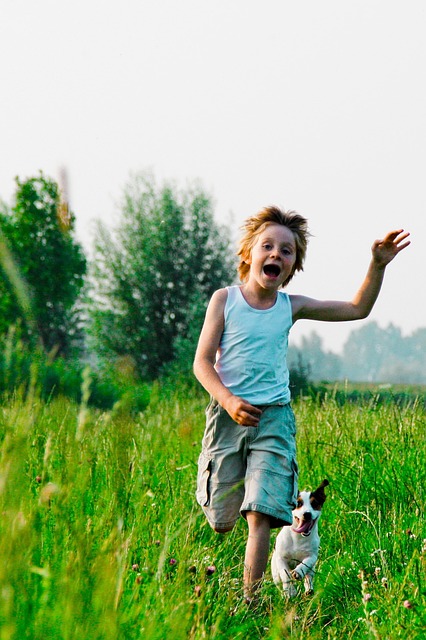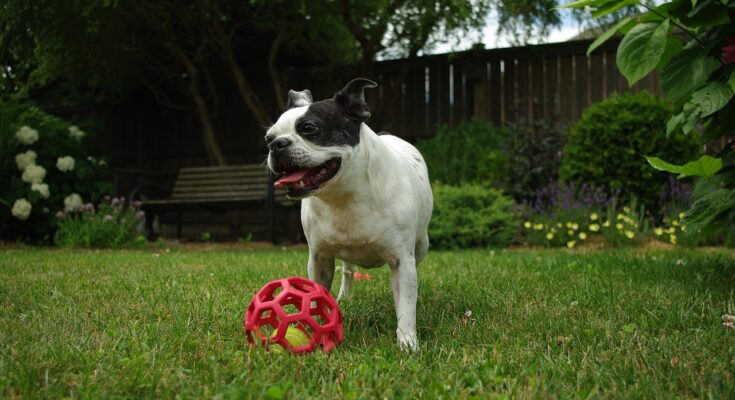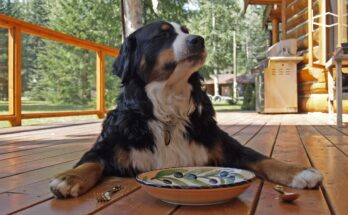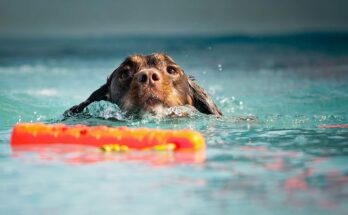Creating a garden that is both beautiful and safe for your furry friend can be a daunting task. You want to create a space that your dog can enjoy without worrying about them getting hurt or destroying your hard work. But fear not, with a little planning and some simple tips and tricks, you can create a dog-friendly garden that both you and your furry companion will love.
First and foremost, when designing a dog-friendly garden, it’s important to consider your dog’s needs and habits. From choosing pet-friendly plants to providing designated play areas, there are several things you can do to create a safe and enjoyable environment for your pooch.
With some careful planning and a bit of creativity, you can create a garden that is not only aesthetically pleasing but also functional for both you and your four-legged friend.
Choose Pet-Friendly Plants
You’ll want to make sure the greenery you pick won’t harm your furry companion, so opt for flora that’s safe for your pup to roam around and explore without worry.
When it comes to pet safe gardening, there are some toxic plants to avoid. These include azaleas, rhododendrons, lilies, and daffodils. These plants can cause vomiting, diarrhea, and even death if ingested by your dog.
Instead, choose plants that are safe for your dog to be around, such as marigolds, sunflowers, and snapdragons. You can also add some herbs to your garden, such as parsley, oregano, and thyme, which are all safe and beneficial for your pup.
By selecting the right plants, you can ensure that your garden is a safe and enjoyable place for your furry friend to play and explore.
Designate Play Areas

Designating specific areas for playtime will ensure your furry friend has plenty of space to romp around in and enjoy themselves. It’s important to designate boundaries for your dog’s play area, especially if you have a larger garden. You can create these boundaries using fencing or other visual markers such as potted plants or garden ornaments. This will not only keep your dog contained but also prevent them from damaging other areas of your garden.
Dog proofing your garden is also essential when designating a play area. Make sure to remove any hazardous materials such as sharp objects, poisonous plants, or chemicals that could harm your dog. Additionally, ensure that any objects that could be a choking hazard, such as small rocks or toys, are removed from the play area.
Finally, consider providing shade and water for your pooch, especially on hot summer days, so they can play comfortably and stay hydrated. By following these tips, you can create a safe and enjoyable play area for your furry friend to enjoy.
Install a Fence
If you want to give your furry friend some freedom to run and play in your outdoor space, installing a fence is a great option. A fence can provide a safe and secure space for your dog to roam around without worrying about them running off.
When it comes to installing a fence, you have the option of doing it yourself or hiring a professional. DIY installation can save you some money, but it requires some level of expertise, and you may need to buy or rent specialized tools. On the other hand, a professional installation may cost more, but you’ll have peace of mind knowing that the installation is done correctly.
Choosing the right fence material is also crucial when it comes to creating a dog-friendly garden. You want to choose a fence that is durable, resistant to wear and tear, and able to withstand any weather conditions.
Some popular fence materials include wood, vinyl, and metal. Wood fences are aesthetically pleasing and offer good privacy, but they require regular maintenance. Vinyl fences are low maintenance and come in a variety of colors and styles, but they may not be as durable as metal or wood. Metal fences, such as chain link, are durable and secure, but they may not offer as much privacy as wood or vinyl.
Ultimately, the fence material you choose will depend on your needs and preferences.
Create Paths and Walkways
To make it easier for you to enjoy your outdoor space and for your furry friend to explore, consider adding paths and walkways to your garden. Creative designs can add a unique touch to your space and make it more visually appealing. You can choose from various materials such as gravel, paving stones, or even wood chips to create a path that suits your garden’s style.
The path can be straight or winding, depending on your preferences. In addition to being aesthetically pleasing, walkways can also provide accessibility options for your dog. They can help older dogs or dogs with mobility issues navigate your garden with ease.
Furthermore, designated walkways can reduce wear and tear on your lawn caused by frequent foot traffic. So, not only will your garden look better, but it will also be more practical for your furry companion. Consider adding walkways to your garden as a way to improve your outdoor space for both you and your dog.
Provide Water and Food Stations
When it comes to providing water and food stations for your furry friend, there are a few key things to keep in mind.
Firstly, it’s important to choose the right bowl for your dog’s needs. Consider their size, breed, and any medical issues they may have.
Secondly, installing a water fountain can be a great way to keep your dog hydrated and encourage them to drink more water.
Lastly, adding a shade over the food station can help keep your dog comfortable and protect their food from the sun.
By taking these steps, you can create a safe and comfortable space for your dog to eat and drink in your garden.
Choose the Right Bowl
You need a sturdy and non-slip bowl so your furry friend can enjoy their water and food without spilling it all over the place. When choosing the right bowl for your dog-friendly garden, keep in mind the following:
- Choose the right size: Make sure the bowl is big enough to hold the amount of food and water your dog needs, but not so big that it takes up too much space in your garden.
- Consider the material: Look for a bowl made of safe and durable materials such as stainless steel, ceramic, or silicone. Avoid plastic bowls that can harbor bacteria and break easily.
- Placement is key: Place the bowl in a shady and quiet spot, away from foot traffic and other distractions. This will help your dog relax and enjoy their meal in peace.
- Decorate with dog bowls: Don’t be afraid to incorporate the bowl into your garden aesthetic. You can choose a bowl that matches your garden décor or even paint it to add a pop of color. Just make sure the paint is safe for your dog to lick.
Remember, your dog’s bowl is not just a functional item but a part of their daily routine. Choosing the right bowl and placing it in the right spot will help your furry friend stay hydrated and nourished while enjoying your beautiful garden.
Install a Water Fountain
If you want to add a cool and refreshing feature to your pup’s outdoor oasis, installing a water fountain is a great idea! Not only does it provide a constant source of fresh water for your furry friend, but it also adds a decorative element to your garden. Plus, the sound of running water can have a calming effect on dogs, making it an ideal addition for pups who get anxious or stressed easily.
When choosing a water fountain for your dog, there are a few things to consider. First, make sure the fountain is made of durable materials that can withstand the elements and your dog’s playful nature. Look for fountains that are made of high-quality, non-toxic materials, and that have a sturdy base to prevent tipping.
Additionally, consider the size of the fountain and the amount of water it can hold to ensure that your dog always has access to enough water. With a little research, you can find the perfect water fountain to keep your pup hydrated and happy in your dog-friendly garden.
Add a Shade for the Food Station
Adding a shade to the food station won’t just protect your pup’s meals from the sun’s harmful rays, but it’ll also enhance the aesthetic of your outdoor oasis.
There are numerous creative and affordable ways to create a shaded area for your furry friend. You can use a simple patio umbrella, a retractable awning, or even build a custom pergola to provide shade for your pet’s food and water bowls.
The benefits of adding a shade for pets go beyond just aesthetics. The harsh sun can make your pup’s food unappetizing and cause dehydration. By creating a shaded area, you can ensure that your pet’s meals are always fresh and that they’re protected from the sun’s harmful effects.
Additionally, having a shaded food station can prevent other animals from being attracted to your pet’s food, ensuring their safety and well-being. So, don’t hesitate to add a shade to your dog-friendly garden and make it a comfortable and welcoming space for your furry friend.
Add Outdoor Furniture
When it comes to adding outdoor furniture to your dog-friendly garden, there are a few key points to keep in mind. First, choose durable and easy-to-clean materials that can withstand the wear and tear of both you and your furry friend.
Second, provide comfortable seating for both you and your dog so you can enjoy the space together.
And finally, consider adding a sunshade or umbrella to provide some relief from the sun.
By keeping these tips in mind, you can create a functional and enjoyable outdoor space for you and your pup to relax in.
Choose Durable and Easy-to-Clean Materials
Opt for tough and low-maintenance materials so that your outdoor space can withstand your furry friend’s rough and tumble ways, making the upkeep a piece of cake. When choosing outdoor furniture, pick materials that can withstand exposure to the elements and your dog’s playful antics.
Here are a few tips to help you choose the right materials for your dog-friendly garden:
- Consider metal or plastic furniture. These materials are easy to clean and maintain and are resistant to scratches and bites.
- Choose outdoor fabrics that are durable and stain-resistant. Look for materials that can be washed easily and won’t fade in the sun.
- Opt for stone or concrete paving. These materials are tough and can withstand the weight of your dog without getting damaged.
- Avoid materials like wood or wicker that can easily get damaged or stained. If you must use these materials, make sure to use a sealant to protect them from your dog’s urine and scratches.
By choosing durable and easy-to-clean materials, you can keep your outdoor space looking great while also ensuring your furry friend has a safe and enjoyable space to play in. With the right cleaning techniques and material longevity, you can maintain your garden for years to come.
Provide Comfortable Seating for Both You and Your Dog
Make sure you and your furry companion can relax in comfort by providing cozy seating options that cater to both of your needs. Consider investing in outdoor furniture that’s sturdy and easy to clean, such as metal or plastic chairs and tables. You can also incorporate pet-friendly fabrics, like outdoor fabrics that are water-resistant and can easily be wiped down if your dog drools or sheds on them. This will ensure that your seating area remains comfortable and clean for both you and your dog.
Additionally, consider creating a designated digging area for your dog. Many dogs love to dig, and allowing them to do so in a specific area can prevent them from ruining your garden or flower beds. You can create a designated digging area by outlining a section of your garden with rocks or fencing, and filling it with sand or dirt. Encourage your dog to use this area by burying toys or treats in the dirt, and praising them when they dig there.
With these simple adjustments, you and your furry friend can enjoy a comfortable and functional garden space together.
Consider Adding a Sunshade or Umbrella
To truly bask in the beauty of your outdoor oasis with your furry friend by your side, don’t forget to shield yourself from the scorching sun by adding a sunshade or umbrella to your seating area. A shaded area not only provides relief from the heat but also adds a cozy touch to your garden.
As you lounge with your canine companion, you’ll enjoy the comfort and protection that a sunshade or umbrella provides. When choosing a sunshade or umbrella, consider both style and durability. Here are some tips to help you choose the perfect sunshade or umbrella for your dog-friendly garden:
- Look for a design that complements your garden’s aesthetic.
- Choose a durable fabric that can withstand the elements and is easy to clean.
- Consider the size of the sunshade or umbrella to ensure it provides enough shade for you and your furry friend.
- Opt for a model that is adjustable to accommodate different times of day and different angles of the sun.
- Don’t forget to secure the sunshade or umbrella to prevent it from toppling over on windy days.
Maintain Your Dog-Friendly Garden
Now that your garden is set up for your furry friend, let’s talk about how to keep it that way.
The first step is to train your dog to respect the boundaries and rules you’ve set up. It’s important to establish clear rules and boundaries from the beginning, using positive reinforcement and rewards to encourage good behavior. This will prevent your dog from digging up plants, running through flower beds, or trampling on delicate foliage.
Consistency is key, so make sure to reinforce these rules every time you take your dog out into the garden.
In addition to training, seasonal maintenance is important for keeping your dog-friendly garden in top condition. This includes regular mowing, trimming, and weeding to keep the garden tidy and safe for your pet.
Make sure to remove any hazardous plants or toxic chemicals that could harm your dog, and keep an eye out for any signs of pests or disease. Regular watering and fertilizing will help your plants thrive, while also creating a lush and inviting space for your furry friend to enjoy.
With a little bit of care and attention, your dog-friendly garden can be a beautiful and safe haven for both you and your canine companion.
Frequently Asked Questions
What are some common mistakes to avoid when creating a dog-friendly garden?
As the saying goes, “an ounce of prevention is worth a pound of cure.” When it comes to creating a dog-friendly garden, there are a few common mistakes you’ll want to avoid.
First and foremost, don’t assume that your furry friend will instinctively know how to behave in the garden. Proper training methods are key to ensuring that your dog won’t destroy your hard work or harm themselves in the process.
Additionally, be sure to choose pet-friendly landscaping that won’t be harmful to your dog if ingested.
With a little bit of knowledge and experience, you can create a garden that is both beautiful and safe for your four-legged friend to enjoy.
How can I protect my plants and flowers from my dog’s digging and chewing habits?
Protecting your plants and flowers from your dog’s digging and chewing habits can be challenging, but there are effective solutions.
Training techniques can be used to teach your dog to stay away from certain areas or to stop digging and chewing altogether.
Non-toxic deterrents such as sprays or granules can also be used to discourage your dog from damaging your plants and flowers. It’s important to choose a deterrent that is safe for both your dog and your garden.
With patience and consistency, you can train your dog to respect your garden and enjoy it without causing any harm.
Are there any specific types of grass that are better for dogs to play on?
When it comes to creating a dog-friendly garden, you’ll want to make sure you choose the best grass options for your furry friend to play on. Did you know that certain types of grass are actually better suited for dogs than others?
For example, Bermuda grass is a popular choice because it’s durable and can withstand heavy traffic from pets. On the other hand, if you’re considering artificial turf for your dog friendly garden, there are pros and cons to consider. While it can be low maintenance and easy to clean up after your pet, it can also get hot and uncomfortable for your dog during the summer months.
As someone who has experience creating a dog-friendly garden, it’s important to weigh these options and choose what will work best for you and your furry companion.
What are some alternative options to a traditional fence for keeping my dog contained in the garden?
When it comes to containing your dog in your garden, you have several options beyond the traditional fence. Dog-friendly barriers are a great alternative, as they’re designed to keep your furry friend safe and secure while also being aesthetically pleasing.
These barriers come in various forms, including hedges, garden beds, and trellises, and can be used to create a natural barrier around your garden. Another option is invisible fencing, which uses a buried wire and a collar to create a boundary for your dog.
This option is great for those who want to keep their garden open and free of visible barriers. No matter which option you choose, it’s important to ensure the safety of your dog while also maintaining the beauty of your garden.
How can I incorporate my dog’s preferences and needs into the overall design of the garden?
When designing your garden, it’s important to consider your furry friend’s preferences and needs.
For example, if your dog loves to dig, you could create a designated digging area filled with sand or soil.
You could also incorporate a sensory experience by adding plants with different textures and scents, like lavender or mint.
A shaded area with a cozy bed or shelter can provide a comfortable spot for your pup to relax and escape the sun.
Water features, like a small pond or fountain, can also provide entertainment and hydration for your dog.
By incorporating these elements into your dog-friendly design, you can create a space that not only looks beautiful but also caters to your dog’s unique needs and desires.
Conclusion
Congratulations on creating a beautiful dog-friendly garden! You’ve taken the necessary steps to ensure your furry friend can enjoy the outdoors safely and comfortably. By choosing pet-friendly plants, designating play areas, installing a fence, creating paths and walkways, providing water and food stations, and adding outdoor furniture, you’ve created a space that both you and your dog can appreciate.
As you sit back and admire your new garden, remember that it’s important to maintain it regularly. Remove any hazardous plants or objects, keep the grass trimmed, and clean up after your dog to ensure a safe and healthy environment.
By following these tips and tricks, you’re not only creating a space for your dog, but you’re also contributing to a happier and healthier lifestyle for both you and your furry companion.
In conclusion, creating a dog-friendly garden requires patience, effort, and a lot of love. You’ve done an excellent job in providing your dog with a safe and enjoyable outdoor space. As you continue to maintain and improve your garden, remember the joy and companionship your furry friend brings to your life and how much they deserve a space that caters to their needs.
Keep up the good work, and enjoy the many adventures you’ll have with your furry friend in your beautiful dog-friendly garden.




